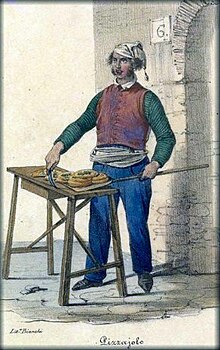Le Corricolo
 A corricolo in Naples in 1850 | |
| Author | Alexandre Dumas |
|---|---|
| Original title | Le Corricolo |
| Country | France |
| Language | French |
| Genre | Travel book |
Publication date | 1841 – 1843 |
Le Corricolo, published in English as Sketches of Naples, is a work by Alexandre Dumas published in 1843, in which he recalls the trip he made from Rome to Naples in 1835, with the painter Louis Godefroy Jadin. In the work Dumas alternates episodes he experienced with others coming from the popular tradition.
The trip to Italy
The original idea of Dumas was a trip along the coast of the whole Mediterranean.
Description

Published in four volumes, which came out between 1841 and 1843, Le Corricolo collects a series of tales inspired by anecdotes, stories, portraits, puns and stories of excursions, that Alexandre Dumas recorded in 1835, when he visited Naples and southern Italy, so much so that, in the English edition, it was published under the title Sketches of Naples. It concludes the author's impressions of his travels in the Kingdom of Naples with his stay in Naples, following on from the two volumes Speronare and Capitaine Aréna, which recounted his travels respectively in Sicily and Calabria with the Aeolian Islands.[3]
A widespread literary tradition has attributed the work to Pier Angelo Fiorentino,[5] one of the French novelist's collaborators, whom the writer got to know during his trip to Italy in 1835, which provided him with the material for this book.[6][7]
The title refers to the means of transport Dumas used to visit the Naples area. As Dumas explains, "Le Corricolo is a kind of tilbury originally intended to hold one person and to be hitched to a horse; it is hitched to two horses, and carries from twelve to fifteen people."[8]
In Le Corricolo Dumas alternates episodes he witnessed or were told to him with others coming from the popular tradition.[1]
Of the tales included in it, many of which were inspired, according to Benedetto Croce, by anecdotes published in 1830 by Michele Palmieri di Micciché,[9] those on the Lazzaroni[10] and those on the evil eye[11] have attracted particular attention from a socio-anthropological perspective.
The book is also noteworthy because it contains one of the first literary accounts of Neapolitan pizza,[12][13][14] which Dumas uses to make a socio-economic analysis of the city:[15][16]
Pizza is: with oil; with bacon; with lard; with cheese; with tomatoes; with small fish. It is the gastronomic thermometer of the market: it rises or falls in price according to the course of the aforementioned ingredients, according to the abundance or famine of the year.
References
- ^ ISBN 9782381850153. Archived from the original on 2023-04-10. Retrieved 2023-04-10.)
{{cite book}}:|work=ignored (help - ^ de Cesare (1997), p. 805
- ^ a b c d e Noël Lebeaupin. "Le Coricolo". Alexandre Dumas. Deux Siècles de Littérature vivante (in French). Archived from the original on 2022-09-29. Retrieved 2023-04-09.
- ^ de Cesare (1997), p. 826
- ^ Benedetto Croce (1949). Benedetto Croce (ed.). Note sul «Corricolo» di Alessandro Dumas (in Italian). Vol. II. Napoli: Ricciardi. p. 242-246.
{{cite book}}:|work=ignored (help) - ^ de Cesare (1997), p. 843
- ^ Giuseppe Monsagrati (1997). FIORENTINO, Pier Angelo (in Italian). Vol. 48. Rome: Treccani. Retrieved 15 April 2023.
{{cite encyclopedia}}:|work=ignored (help) - ^ Dumas, Le Corricolo, Introduction.
- ^ Michele Palmieri di Micciché (1830). "Pensées et souvenirs historiques et contemporaines" (in French). Paris. Archived from the original on 2023-05-07. Retrieved 2023-04-10.
- ISBN 9782862724300. Archived from the original on 2023-05-07. Retrieved 2023-04-10.)
{{cite book}}: CS1 maint: location missing publisher (link - ^ Ernesto De Martino (2001). Sud e magia (in Italian). Milano: Feltrinelli. p. 159-164.
- ^ "Pizza". Enciclopedia Treccani (in Italian). Retrieved 10 April 2023.
...la moderna pizza napoletana, le cui prime descrizioni provengono da fonti d'eccezione quali A. Dumas (1835), E. Rocco (1858) e S. Di Giacomo (1893).
- ^ Gennaro De Gregorio (12 May 2020). "Storia della Pizza". academia.edu (in Italian). p. 8. Archived from the original on 15 April 2023. Retrieved 9 April 2023.
- ^ Antonio Fucito (12 December 2022). "Pizza: le prime testimonianze storiche, tra libri e fotografie" (in Italian). Archived from the original on 10 April 2023. Retrieved 10 April 2023.
- ^ Rovagnati. "Breve storia della pizza". Corriere della Sera (in Italian). Archived from the original on 9 April 2023. Retrieved 9 April 2023.
- ^ Dumas, Alexandre. "Le Corricolo: Chapitre VIII, Le lazzarone" (in French). Société des Amis d'Alexandre Dumas. Archived from the original on 5 December 2022. Retrieved 12 June 2023.
Sources
- Raffaele de Cesare (1997). "Il viaggio di A. Dumas in Italia nel 1835". Aevum (in Italian). 3 (September-December 1997): 801–860. Retrieved 9 April 2023.
